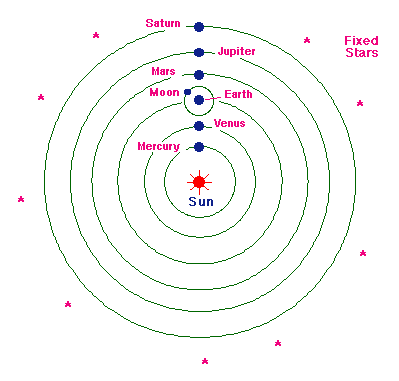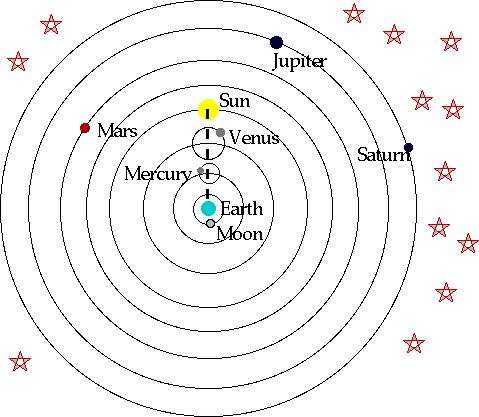Introduction
For almost two thousand years, the earth was believed to form the center of the solar system. However, in early 16th century Nicolas Copernicus (an astronomer of the Polish origin) proposed a new perspective that, the earth was just a planet like any other and did not form the center of the solar system. He rather proposed that, the sun was the center of the solar system; he called his model the heliocentric system. His findings were written in a book called “On the Revolutions of the Heavenly Bodies” which was published after his death. This paper will give an in-depth analysis of the Copernican model, the Ptolemaic model, and then give a comparison between the two models.
Copernican model
Nicolas Copernicus designed his model of the solar system to achieve the greatest simplicity, within his physical and philosophical axiomatic framework. He sought to eliminate the unnecessary hypothesis of the Ancients concerning coincidences and correlations of planetary orbits by explaining these orbits in terms of his heliocentric approach. The Copernican model of the solar system consists of the central star sun surrounded by a family of planets in concentric circular orbits. Whether we accept Copernican model or the multi-star model of the solar system is a philosophical choice rather than a scientific decision. He came up with a new ordering of the solar system as illustrated in the figure below (Anon. “The Copernican Model”1)

From Copernican order of the solar system, we realize that, the Earth is placed in third position from the sun and that the moon goes around the earth it’s an orbit. The Earth goes around the sun once every day causing the stars to rotate around it in the other direction. Copernicus was able to prove that the sun and not the earth was the center of the solar system but held unto the assumption of circular motion. He found that, all the planets rotate around the sun in a circular motion but the time taken by each planet to complete one rotation differs. The planets which are closer to the sun take a shorter time as compared to the ones further from the sun. Each planet has an orbit called ellipses in which it rotates around the sun.
Despite all the research, Copernicus had carried out, he feared publishing his book because he did know how the other astronomers and the church would react. That’s why; his book was only published soon after his death. However, for over one hundred years, his book was widely accepted and used in the study of astronomy. Other astronomers emerged later to criticize his findings but were not able to completely do away with his work and it still forms the basis of the study of the astronomy. The most commonly used aspect of Copernicus’s model is that the solar system is heliocentric.
That is, the earth, moon, and planets relate around the sun in a uniform circular motion. This approach has one main advantage in that, if we are able to accept the fact that, the sun is stationary, then it is understandable that, the epicycles of the bigger planets to those of the inferior planets explains the orbit of the earth and thus all of the circles must be equal ((Anon. “The Copernican Model”4).
The Ptolemaic model
The Ptolemaic model was first developed in the second century. It was believed to be a complicated astronomical system that managed to estimate the position of each planet. Ptolemy observed that the motion of the planets would only be estimated through a mathematical devise and that the model that gives the right answer should be adopted since it is hard to know the truth. Ptolemy’ model assumed that, the earth and not the sun was the center of the solar system. Just like Copernicus, Ptolemy found that, planets move on an epicycle that moves in a much bigger circle referred to as a deferent. He assumed that the stars move around the spheres of the other planets.
This findings contrast with Copernicus finding in that, according to Copernicus,, the stars wove around the earth in an opposite motion to the earth’s movement around the sun. The following figure is an illustration of Ptolemy’s solar system (Anon. “Copernicus vs. Ptolemy” 2).

Comparison between Copernican model and Ptolemaic model
Copernicus model gives a deeper analysis of the solar systems and it is a better version as compared to the Ptolemy’s model. For instance, Copernicus rejected Ptolemy’s equant scheme and found out that, all the heavenly bodies move in uniform circles. Both motions move in the same direction uniformly although one is faster than the other. However, both Copernicus’ model and Ptolemy’s contains equal numbers of epicycles although Ptolemy’s epicycles are bigger than Copernicus.
Copernicus’s assertion that the sun was the center of the solar system was driven by two forces. The first force was the failure of Ptolemaic model to give precise prediction about the positions of the planets. This is because Ptolemaic relied on mathematical devices and the device which was believed to produce easy predictions was assumed to be true. The second reason was that, Copernicus was opposed to the fact that Ptolemy used big epicycles to elucidate the retrospective motions of the planets. According to him, the motion of the planets could be elucidated by assuming that the earth also moves around the sun (Betz 65).
The Ptolemaic explanation derives from a model that captures little of the physical reality of the solar system. Unlike the Ptolemaic model, Copernican model represents the solar system as a proper system. The Ptolemaic model held that everything (including the sun) revolves around the Earth, a special object in the model
Because Copernicus imposed uniform circular motion on his model, it could not accurately predict the motions of the planets as compared to Ptolemy’s model. However, Copernicus model was more elegant in idea than the Ptolemy’s model. Placing the sun at the center of the universe produced a symmetry among the motions of the planets that was pleasing to the eye and to the intellect. All of the planets moved in the same direction at speeds that were simply related to their distance from the sun. In the Ptolemaic model, the planets were not treated equally like in Copernican model, for instance the epicycles of Venus and Mercury remained at the center on the Earth-sun line (Anon. “Copernicus vs. Ptolemy” 2).
The model may have eventually won support for its elegance more than its accuracy. The Copernican model relies on uniform circular motion and consequently does not precisely describe the motions of the planets, but the Copernican hypothesis that the universe is heliocentric was correct. Despite his flawed model, Copernican’s hypothesis was a groundbreaking moment in the history of astronomy.
Although Copernicus proposed a revolutionary idea in making the planetary system heliocentric, he was a classical astronomer with tremendous respect for the old concept of uniform circular motion. In fact, Copernicus objected strongly to Ptolemy’s use of the equant. The gradual acceptance of the Copernicus hypothesis has been named the Copernican Revolution because it involved not just the adoption of a new idea but a total revolution in the way astronomers thought about the place of the Earth.
Copernicus believed that the most important feature of astronomy is that all heavenly motions must be uniform circular motion. Copernicus had a revolutionary idea that the solar system is centered on the sun, but his insistence upon uniform velocities and circular motion was wrong (Betz 65). Perhaps the present situation in cosmology is similar to the situation after Copernicus, but before Kepler and Newton.
Conclusion
We would expect that the Copernican system succeeds better at explaining the asymmetry of season across the hemispheres. As the Copernican model deals with the planets as a system, it has no difficulty in explaining the asymmetry of the seasons and the varying lengths of the days. In this sense, the Copernican model has a grater explanatory power: by adopting the mobility of the earth, it naturally explains retrograde motions, the seasons, and the relative distance of the planets from the sun. But the Copernican system is more unwidely than the Ptolemaic model, at least in this respect. Nevertheless, it retains a closer fit to the solar system than the Ptolemaic model
Works Cited
Anon. “Copernicus vs. Ptolemy: How do we know what is “right” in science.” Web.
Anon. “The Copernican Model: A sun-centered solar system.” Web.
Betz, Fredrick. Managing technological innovation: competitive advantage from change. New York: wiley- IEEE, 2003.